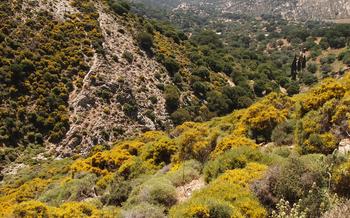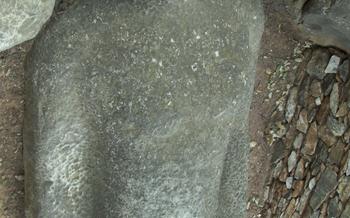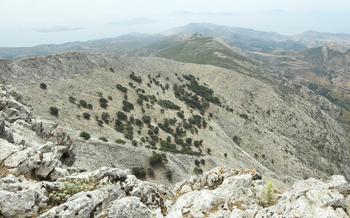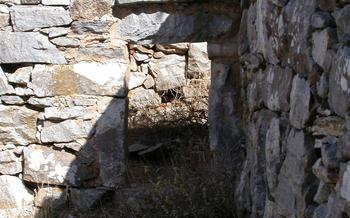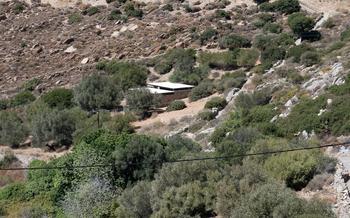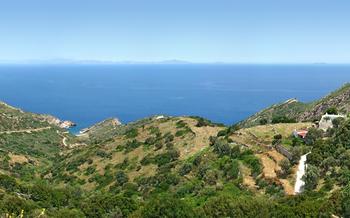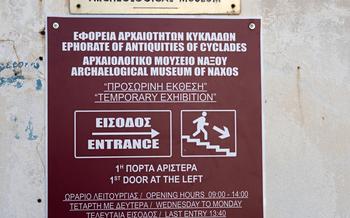
Portara Temple of Apollo
- The Portara of Naxos: A Timeless Icon
- Unveiling the History of the Portara
- Location and Accessibility
- Exploring the Islet of Palatia
- Witnessing the Spectacular Sunset
- Unveiling the Archaeological Museum of Naxos
- Discovering the Venetian Castle of Naxos
- Indulging in Naxian Cuisine
- Exploring the Beaches of Naxos
- Venturing into the Naxos Mountains
- Unveiling the Kouros of Melanes: A Masterpiece Frozen in Time
- Visiting the Temple of Demeter
- Insider Tip: Unveiling the Hidden Gems of Naxos
The Portara of Naxos: A Timeless Icon
The Portara of Naxos, an iconic ancient Greek temple gate, stands majestically on the islet of Palatia, just off the coast of Naxos, the largest island in the Cyclades group. This monumental structure has captivated visitors for centuries with its historical significance, architectural grandeur, and symbolic allure. As a symbol of Naxos' rich history and cultural heritage, the Portara beckons travelers to step back in time and explore the fascinating world of ancient Greece.
Built in the 6th century BC, the Portara was conceived as the grand entrance to a temple dedicated to Apollo, the Greek god of music, poetry, and prophecy. However, the temple was never completed, and the Portara remains a solitary yet awe-inspiring testament to the architectural prowess of the ancient Greeks. Standing at over 6 meters high and 5 meters wide, the Portara's colossal marble blocks exude an aura of strength and resilience that has withstood the passage of time and the elements.
Beyond its architectural significance, the Portara holds a deep symbolic meaning. In ancient Greek mythology, Naxos was the birthplace of Dionysus, the god of wine and revelry. The Portara is believed to have been the site where Dionysus first arrived on the island, and it is said that his followers would gather here to celebrate his arrival with music, dance, and libations.
Today, the Portara stands as a symbol of Naxos' enduring spirit and its connection to the ancient world. It is a testament to the island's rich cultural heritage and a reminder of the powerful legacy of ancient Greece.
Unveiling the History of the Portara
The Portara of Naxos stands as a testament to the rich history and ancient civilization of the island. Its origins can be traced back to the 6th century BC, during the reign of the tyrant Lygdamis. The temple was dedicated to the Greek god Apollo, who was widely worshipped throughout the region.
The construction of the Portara was part of an ambitious project to build a magnificent temple complex on the islet of Palatia. However, due to political turmoil and financial constraints, the temple remained unfinished, leaving only the grand entrance gate standing today.
The Portara served not only as a religious sanctuary but also as a symbol of power and prosperity for the Naxians. It was believed that the temple would bring good fortune and protection to the island. The unfinished state of the temple has sparked much debate among scholars, with some suggesting that it was abandoned due to a change in religious beliefs or a shift in political power.
Archaeological excavations conducted around the Portara have revealed a wealth of artifacts and inscriptions, shedding light on the religious practices and daily life of the ancient Naxians. These discoveries have provided valuable insights into the history and significance of the Portara, making it a priceless treasure for archaeologists and historians.
Location and Accessibility
The Portara is situated on the islet of Palatia, a small island just off the coast of Naxos Town. Its strategic position, facing the Aegean Sea, made it an important landmark for ancient seafarers and travelers. Today, the islet is easily accessible via ferry from Naxos Town, with frequent departures throughout the day. Visitors can also opt for a scenic walk or a leisurely boat tour to reach the Portara, enjoying the breathtaking views of the surrounding landscape. Once on the islet, visitors are greeted by a tranquil atmosphere and serene surroundings, making it an ideal place to explore, relax, and soak up the rich history and beauty of this ancient site.
Exploring the Islet of Palatia
The islet of Palatia, where the Portara stands majestically, is a haven of natural beauty and historical significance. The islet's pristine beaches, with their golden sands and crystal-clear waters, invite visitors to bask in the Mediterranean sun and indulge in refreshing swims. Amidst the tranquil atmosphere and serene surroundings, the islet reveals its ancient past through scattered ruins and historical sites. These remnants of a bygone era, including ancient fortifications and remnants of settlements, provide a glimpse into the rich history of Palatia and Naxos.
Whether seeking relaxation, swimming, or exploration, the islet of Palatia offers a captivating experience. Visitors can unwind on the secluded beaches, soak up the sun's warmth, and let the gentle sea breeze soothe their senses. For those seeking adventure, the islet's hidden paths and ancient ruins beckon to be explored, revealing the secrets of a forgotten past. The islet of Palatia is a sanctuary of natural beauty, historical charm, and serene tranquility, offering a perfect escape from the bustling mainland.
Witnessing the Spectacular Sunset
The Portara of Naxos offers an unparalleled setting to witness the breathtaking sunset over the Aegean Sea. As the sun begins its descent, the sky transforms into a canvas of vibrant colors, casting a golden glow upon the ancient marble structure. The interplay of light and shadow creates a magical atmosphere, making it a must-see experience for visitors. Whether you choose to sit atop the Portara or find a spot along the islet's shore, the sunset views from this iconic landmark are simply unforgettable. Embrace the tranquility and romance of the moment as you watch the sun dip below the horizon, leaving behind a trail of shimmering colors that dance across the water's surface. Prepare to be mesmerized by the beauty of nature and the enduring legacy of the Portara, a timeless symbol of Naxos' rich history and cultural heritage.
Unveiling the Archaeological Museum of Naxos
Nestled in the heart of Naxos Town, the Archaeological Museum stands as a testament to the island's rich history and cultural heritage. Within its walls, a treasure trove of artifacts awaits, inviting visitors on a journey through time. Discover ancient pottery, intricate sculptures, and fascinating relics excavated from the Portara and other significant sites across Naxos.
The museum's collection offers a glimpse into the island's ancient civilization, shedding light on its religious practices, daily life, and artistic achievements. Admire the delicate figurines, finely crafted jewelry, and impressive statues that erzählen from a time long past. Each artifact holds a story, providing a tangible connection to Naxos' vibrant past.
A visit to the Archaeological Museum is a complementary experience to exploring the Portara. It enhances the understanding of the island's history and provides a deeper appreciation for the significance of this iconic landmark. Through the museum's exhibits, visitors gain a comprehensive insight into the rich tapestry of Naxian culture.
Discovering the Venetian Castle of Naxos
Naxos is not only home to ancient ruins and stunning beaches but also boasts a magnificent Venetian castle that stands as a testament to the island's rich medieval past. Perched atop a hill overlooking the harbor, the castle offers breathtaking panoramic views of the town, the Aegean Sea, and the surrounding countryside.
Built in the 13th century by the Venetian family, the Sanudos, who ruled over Naxos for several centuries, the castle served as their administrative center and residence. Its imposing walls, towers, and ramparts reflect the architectural prowess of the Venetians, combining elements of Gothic and Byzantine styles.
Exploring the castle's interior is a journey through time, as visitors can wander through its narrow streets and charming alleys, discovering hidden courtyards, vaulted chambers, and elegant arches. The castle is home to several churches, including the impressive 13th-century Panagia Protothronos, which features exquisite frescoes and intricate carvings.
From the castle walls, visitors can enjoy unparalleled views of Naxos Town, the harbor, and the surrounding islands. The castle's strategic position allowed the Venetians to oversee and control maritime trade and defend the island from potential threats.
Visiting the Venetian Castle of Naxos is a must for anyone interested in history, architecture, and stunning views. It offers a unique opportunity to step back in time and experience the grandeur and power of the Venetian era, while immersing oneself in the island's rich cultural heritage.
Indulging in Naxian Cuisine
Naxos is a culinary haven, offering a delightful array of local specialties and traditional dishes that will tantalize your taste buds. Fresh seafood, caught daily from the crystal-clear waters, takes center stage in many dishes, including grilled octopus, succulent shrimp, and flavorful fish stews. Local cheeses, such as graviera and xinomyzithra, are a must-try, showcasing the island's rich dairy tradition.
Venture into the charming tavernas and restaurants scattered throughout the island to savor authentic Naxian cuisine. Sample the hearty ntolmades, stuffed grape leaves filled with rice, herbs, and minced meat, or indulge in the creamy Naxian potatoes, slow-cooked with onions and local herbs. Pair your meal with a glass of Kitron, a refreshing local liqueur distilled from citron fruit, for a truly Naxian culinary experience.
As you explore the island, don't miss the opportunity to visit local markets and shops to purchase fresh produce, artisanal cheeses, and traditional sweets. From juicy fruits and sun-ripened tomatoes to handmade pastries and delectable jams, Naxos offers a plethora of culinary delights to savor and cherish.
Whether you're seeking a casual lunch by the beach, a romantic dinner overlooking the sunset, or a culinary journey through Naxos' traditional flavors, the island's diverse culinary offerings will leave you satisfied and eager for more.
Exploring the Beaches of Naxos
Naxos is renowned for its pristine sandy beaches, stretching along the crystal-clear waters of the Aegean Sea. Whether seeking tranquility, adventure, or a blend of both, Naxos offers a diverse range of beaches to cater to every traveler's desires.
Agios Prokopios and Agia Anna, located on the southwest coast, are popular choices for those seeking organized beaches with sunbeds, umbrellas, and water sports facilities. For a more secluded experience, head to the beaches of Plaka, Kastraki, and Mikri Vigla, where you can bask in the sun's warmth and enjoy the tranquility of your surroundings.
For those seeking an active beach experience, Naxos offers a variety of water sports, including windsurfing, kitesurfing, and scuba diving. The island's consistent winds and clear waters make it an ideal destination for these exhilarating activities.
After a day of sun, sea, and adventure, indulge in the local cuisine at one of the many tavernas and restaurants lining the beaches. Savor fresh seafood, mouthwatering cheeses, and local produce, all while enjoying the stunning views of the Aegean Sea.
Venturing into the Naxos Mountains
Nestled in the heart of Naxos, the majestic mountains beckon adventurers with their rugged beauty and panoramic vistas. Lace up your hiking boots and embark on an invigorating journey through lush forests, cascading waterfalls, and traditional villages perched on hillsides. The trails wind through diverse landscapes, offering breathtaking views of the Aegean Sea, verdant valleys, and neighboring islands.
As you ascend, the air becomes crisp, and the scent of wild thyme and sage fills the air. Marvel at the intricate rock formations and discover hidden caves that have served as shelters for centuries. Along the way, encounter friendly locals tending to their flocks or working in their fields, who will gladly share stories of their mountain life.
For those seeking a challenging hike, conquer Zas, the highest peak of Naxos, standing at an impressive 1,004 meters. The panoramic views from the summit are simply awe-inspiring, encompassing the entire island, the neighboring Cycladic islands, and the vast expanse of the Aegean Sea.
Whether you're an experienced hiker or simply seeking a leisurely stroll, the Naxos Mountains offer trails for all levels of fitness. Embrace the tranquility, soak in the natural beauty, and create lasting memories amidst the unspoiled landscapes of Naxos.
Unveiling the Kouros of Melanes: A Masterpiece Frozen in Time
Amidst the serene landscapes of Naxos, travelers can discover a remarkable sight that speaks to the island's rich history and artistic heritage: the Kouros of Melanes. An unfinished colossal statue dating back to the 6th century BC, the Kouros stands as a testament to the skill and ambition of ancient Greek sculptors.
Carved from a single block of Naxian marble, the Kouros stands at an impressive height of more than 6 meters. Despite its unfinished state, the statue exudes an aura of strength and majesty, its muscular form and intricate details hinting at the masterpiece it could have become.
The Kouros was likely intended to represent a young man or a deity, but its exact purpose remains shrouded in mystery. Some believe it was meant to be placed in a temple or sanctuary, while others suggest it may have been a funerary monument.
Archaeological excavations have revealed several unfinished statues and tools near the Kouros, indicating that it was part of a larger sculptural workshop. These discoveries provide valuable insights into the techniques and processes employed by ancient Greek sculptors.
Today, the Kouros of Melanes stands as a silent guardian of Naxos' past, inviting visitors to contemplate its unfinished beauty and the stories it holds within. Its presence serves as a reminder of the island's deep connection to ancient Greece and the enduring legacy of its artistic traditions.
Visiting the Temple of Demeter
In the heart of Naxos' fertile plains, nestled amidst olive groves and serene landscapes, lies the ancient Temple of Demeter. This sacred site, dedicated to the goddess of agriculture and fertility, offers a glimpse into the island's rich religious heritage and agricultural traditions.
Although only ruins remain today, the Temple of Demeter holds a profound sense of history and spirituality. Visitors can wander among the remnants of the temple, imagining the rituals and ceremonies that once took place within its walls. The tranquil atmosphere and serene surroundings create an ideal setting for contemplation and reflection.
As you explore the site, take note of the architectural features that hint at the temple's former grandeur. The foundations, columns, and intricate carvings provide clues to its construction and significance. Learn about the ancient agricultural practices and rituals associated with Demeter, and how the temple played a central role in the island's agricultural prosperity.
Whether you are a history buff, an archaeology enthusiast, or simply seeking a peaceful retreat, the Temple of Demeter is a must-visit destination on Naxos. Its historical significance, combined with the tranquil surroundings, creates a unique and awe-inspiring experience that will leave you with a deeper appreciation for the island's ancient roots.
Insider Tip: Unveiling the Hidden Gems of Naxos
Beyond the popular tourist trails, Naxos conceals a wealth of hidden treasures waiting to be discovered. Venture off the beaten path to uncover secluded beaches with crystal-clear waters, far from the madding crowds. Explore traditional villages that have retained their authentic charm, where time seems to stand still. Immerse yourself in local festivals, where the spirit of Naxos comes alive with music, dance, and traditional costumes. Discover ancient ruins and archaeological sites that tell the story of the island's rich past. Embark on a culinary adventure, savoring local delicacies in family-run tavernas, where the flavors of Naxos come to life. Whether you seek tranquility, adventure, or a glimpse into the authentic side of the island, Naxos has something to offer every traveler who dares to explore beyond the ordinary.
